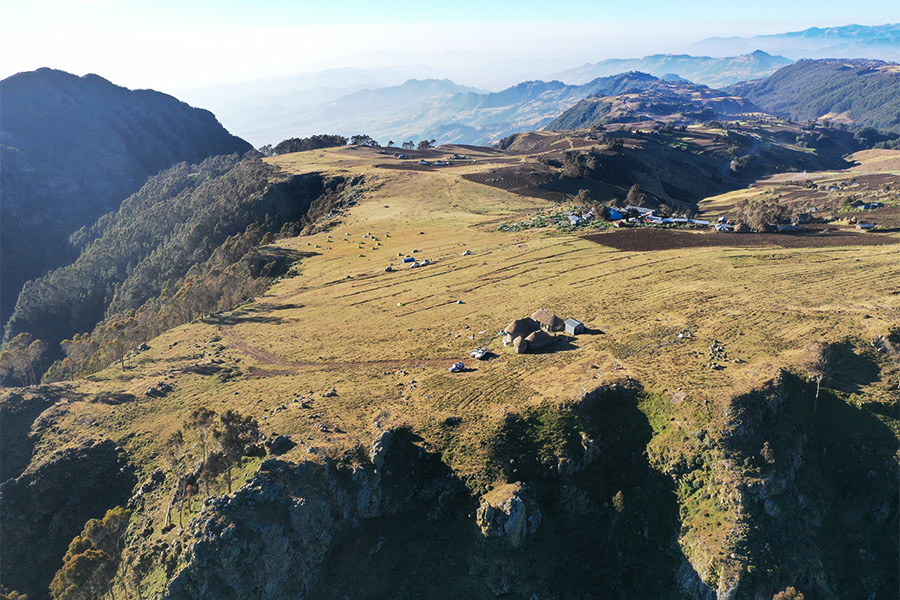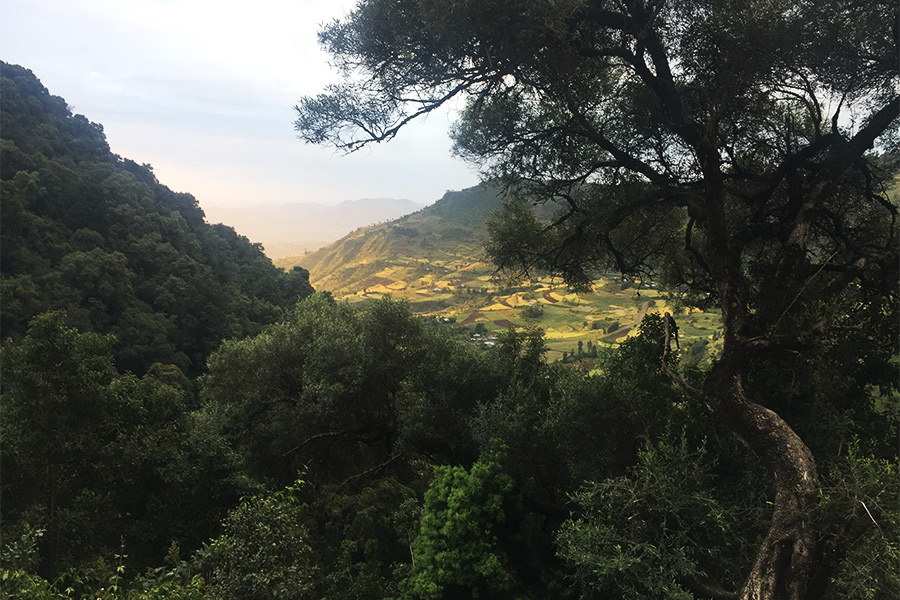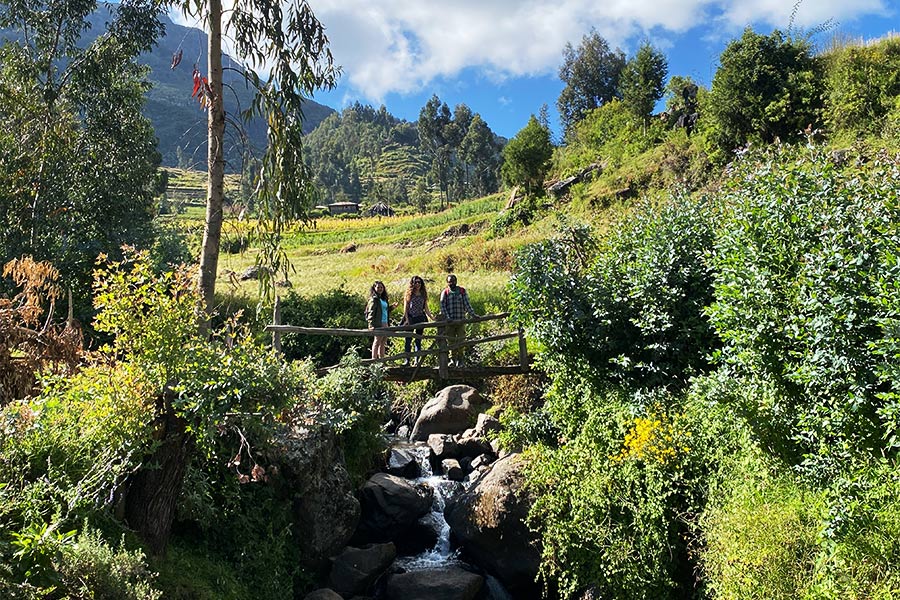Community trekking in Ethiopia
We ventured into the Ethiopian Highlands to meet the locals and experience their nature and wildlife in a sustainable way
Majestic lammergeyer vultures glide by as we rest on a mountain ledge. A diminutive fifth-century church is cocooned in a hillside cave, decorated inside with ancient frescoes. Slopes of green, burgundy, yellow and fiery orange flora overlook unmarked ancient ruins in the sparse land below.
These unexpected experiences are all the more extraordinary because, remote as this place feels – and is – we are passing through the living, present-day communities of the Ethiopian highlands, on a trail in North Wollo between Geneta Mariam and Tadios Amba. Called ‘community trekking’, it’s a unique way to experience the country’s remarkable ‘tableland’.
Community trekking pioneer, Mark Chapman, runs Addis Ababa-based Tesfa Tours. The company enables locally guided, small groups to explore the broad acres, deep valleys, and looming mountains of this high plateau, hosted in traditional agrarian communities in a sustainable and respectful way, that also gives something back.
“Treks now run in Wof Washa Forest, Wollo near Lalibela and Janamora in the Simiens,” explains Mark. “There are 23 guest houses owned and run by communities. As tourism to benefit local people, it’s unique here. Visitors are amazed at the place, and humbled at the hospitality.”

Trekking in the Wof Washa forest, on the Rift Valley escarpment

‘Community trekking’ is no soft option, however. At altitudes between 2,500m and 4,000m above sea level, it’s a challenge. Distances can be long and trails rough. Villages have no electricity or running water, and meals are prepared on a wood fire. Sleep is in ‘tukuls’, circular structures of stone, wood, mud and straw, located at the edges of hosting communities, in high places.
Views are spectacular. Tourists are few. In North Wollo, we encountered just two; in Janamora, none. This solitude intensifies the diverse memories: The simplicity of tea boiled on eucalyptus, or the luxury of highland lamb washed down with Ethiopian red wine (it’s not all hard work). Green-roofed churches set on ridges and in canyons. The ascent of Abuna Yoseph, Ethiopia’s third-highest peak, in the company of Ethiopian wolves, the planet’s rarest canid. Ain Amba, guarded by posturing ‘bleeding heart’ gelada baboons.
Grivet monkeys, spying from undergrowth. Hyenas howling by night, hiding by day. Birds great and small, from kingfishers and sunbirds, to storks, vultures and hawk eagles. Exotic flora, like giant lobelia, in whose leaves baboons may nap. Ethiopia’s giant peak, Ras Dashen, with its draped walls and mysterious 4500-metre heights.

The lush forest at Wof Washa

Above all in the memory remain the highlands’ hardy, smiling inhabitants. A lady prepares Ethiopian coffee al fresco, toasting beans and wafting the aromatic smoke in our faces. We are honoured. Timbala’s lively young hosts serve thyme tea, lentil soup, snacks of roasted pulses and injera with spicy Shiro sauce. They never stop giggling.
Trail encounters, too, are never ending. A village musician plays us through town on his archaic wooden instrument. Itinerant priests bless their fellow travellers. An elderly farmer chats, shoeless in this stony land, but an elegant young lady on a steep, rough trail reminds us that these are just daily paths. Farmhands winnowing, threshing, or ploughing pause to shake hands. Travelling couples of all ages stop to say hello.
Likewise, families lugging water from holes, or balancing baskets of wedding food on their heads. During Timkat, Ethiopia’s communal celebration of public baptism in Geneta Mariam, all sombre rituals, colourful fabrics, energetic song and dance, chaotic processions and rapturous joy, we keep a respectful distance. But the townsfolk would rather we danced with them. We join the throngs descending from all directions on the weekly market in Wosen. And across the land, the air is alive with cries of “hullohullo-hullo”, and the irrepressible energy of children, who will literally run a mile to extend a hand to, talk to and even walk a while with their curious visitors – an Ethiopian welcome this community trekker will never forget.

Trekking through the verdant landscape

Who to go with: Tesfa Tours is a highly committed local organisation run by Briton Mark Chapman, to bring tourists and income sustainably to Ethiopia’s highland communities in Wollo, Wof Washa, Janamora and the Simien mountains. ‘Community trekking’ takes place away from the famed Simien Mountains National Park.
Ways and means: Community guides show the way and ensure visitors have somewhere to sleep and something to eat. Trail snacks, personal hygiene and ‘luxuries’ must be brought. Drinking plenty of water is important at these altitudes. Donkeys are employed to carry gear, but be aware of luggage limits on internal flights. Binoculars, zoom lens and a solar charger are all useful.
Food: Mainly vegetarian meals are prepared by women from the community, including lentil-based soups, beans, potato or pasta, spaghetti with tomato sauce, spinach and cabbage. Ethiopian staples such as injera, keta and flatbread with a hot sauce also figure, as do Ethiopian beer and wine. Breakfast is likely to include tea, coffee, local bread and honey, and scrambled egg.
Climate: Treks take place in Ethiopia’s cool zone – or ‘dega’, mostly around or above 3,000m above sea level. Conditions vary with the season, but nights can be cold all year round. Appropriate clothing, comfortable supportive footwear for long-distance walking, and a good sleeping bag are all essential.
What to take: Remote travel essentials, including first-aid kit, solar charger and energy snacks.